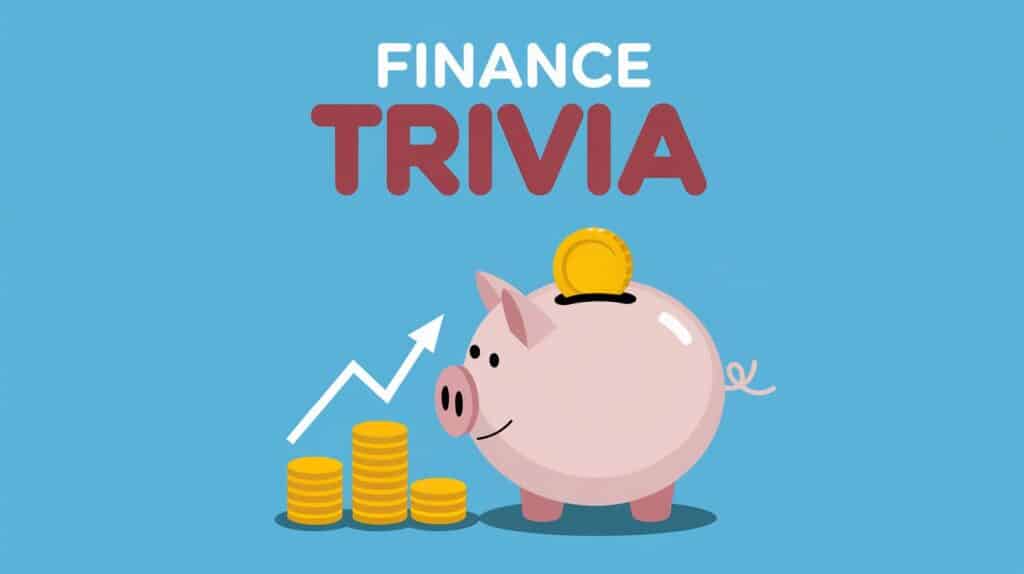Testing your financial knowledge can be tricky.
Many people feel uncertain about money concepts, from basic banking terms to complex market operations. Even experienced professionals sometimes struggle to recall specific financial facts and figures.
Here’s good news: We’ve created a complete set of 175+ finance trivia questions that make learning about money matters fun and engaging.
These questions cover everything from stock markets and cryptocurrencies to personal banking and economic history.
In this collection, you’ll find questions arranged by difficulty levels and topics, perfect for both beginners and finance experts.
Use these questions to test yourself, challenge friends, or make your next team meeting more interesting.
General Finance Knowledge

-
What does the term “liquidity” refer to in finance?
Answer: Liquidity refers to how easily an asset can be converted into cash. -
Who is known as the father of modern economics?
Answer: Adam Smith. -
What is the primary purpose of the Federal Reserve?
Answer: To regulate and control the money supply, manage interest rates, and ensure financial stability. -
What does GDP stand for?
Answer: Gross Domestic Product. -
What is the meaning of the term “inflation”?
Answer: Inflation refers to the rate at which the general level of prices for goods and services is rising, eroding purchasing power. -
What does the acronym “ETF” stand for in investing?
Answer: Exchange-Traded Fund. -
What is a stock dividend?
Answer: A dividend is a payment made by a corporation to its shareholders, usually in the form of cash or additional stock. -
What is a market index?
Answer: A market index is a statistical measure that tracks the performance of a group of stocks or other securities. -
What is the difference between a stock and a bond?
Answer: A stock represents ownership in a company, while a bond is a loan made to a company or government that pays interest over time. -
What does “capital gain” refer to?
Answer: A capital gain is the profit from the sale of an asset like stocks, bonds, or real estate. -
What is a P/E ratio?
Answer: Price-to-Earnings ratio, a measure used to value a company by comparing its current share price to its earnings per share. -
What is the meaning of “diversification” in investing?
Answer: Diversification is the practice of spreading investments across various financial assets to reduce risk. -
Which financial statement shows a company’s profitability over a period of time?
Answer: The income statement. -
What is the “Dow Jones Industrial Average”?
Answer: It is a stock market index that tracks 30 large publicly traded companies in the United States. -
What does “bull market” mean?
Answer: A bull market is a period of rising stock prices.
Investing
-
What is an IPO (Initial Public Offering)?
Answer: An IPO is when a company offers its shares to the public for the first time. -
What is the difference between active and passive investing?
Answer: Active investing involves regular buying and selling of assets, while passive investing involves holding a diversified portfolio long-term. -
What is a blue-chip stock?
Answer: A blue-chip stock is a large, well-established, and financially stable company known for reliable earnings. -
What does “risk tolerance” refer to?
Answer: Risk tolerance refers to an investor’s ability and willingness to endure losses in their investments. -
What is the concept of “compound interest”?
Answer: Compound interest is the interest on both the original amount and the accumulated interest from previous periods. -
What is a “bond yield”?
Answer: Bond yield refers to the return an investor gets on a bond, expressed as a percentage of its face value. -
What is the difference between a traditional IRA and a Roth IRA?
Answer: A traditional IRA offers tax-deductible contributions but taxes withdrawals, while a Roth IRA provides tax-free withdrawals after retirement. -
What is an exchange-traded fund (ETF)?
Answer: An ETF is a type of investment fund that is traded on stock exchanges, much like a stock. -
What does the term “margin trading” refer to?
Answer: Margin trading involves borrowing money from a broker to buy securities, increasing potential returns (and risks). -
What is a mutual fund?
Answer: A mutual fund is a pool of funds collected from many investors to invest in a diversified portfolio of stocks, bonds, or other assets. -
What is a capital loss?
Answer: A capital loss occurs when an asset is sold for less than its original purchase price. -
What is a dividend yield?
Answer: Dividend yield is the annual dividend payment divided by the stock’s price. -
What is a stock split?
Answer: A stock split is when a company issues more shares to shareholders, increasing the total number of shares while decreasing the value per share. -
What is the S&P 500?
Answer: The S&P 500 is a stock market index that tracks 500 large companies listed on stock exchanges in the United States. -
What is a “hedge fund”?
Answer: A hedge fund is a pooled investment fund that employs various strategies to generate high returns for its investors, often using leverage.
Corporate Finance
-
What is the “cost of capital”?
Answer: The cost of capital is the return a company needs to earn to justify the cost of a specific investment or project. -
What is the formula for calculating Net Present Value (NPV)?
Answer: NPV = Σ (Cash inflows / (1 + Discount Rate)^t) – Initial Investment -
What is capital budgeting?
Answer: Capital budgeting is the process companies use to evaluate potential major investments or projects. -
What does “return on equity” (ROE) measure?
Answer: ROE measures a company’s profitability by comparing net income to shareholders’ equity. -
What is the “debt-to-equity ratio”?
Answer: The debt-to-equity ratio measures a company’s financial leverage by comparing its total liabilities to shareholders’ equity. -
What is an “asset” in corporate finance?
Answer: An asset is any resource owned by a company that is expected to provide future economic benefits. -
What is a “financial statement audit”?
Answer: A financial statement audit is an independent examination of a company’s financial records to ensure accuracy and compliance with accounting standards. -
What is a “leveraged buyout” (LBO)?
Answer: An LBO is the acquisition of a company using a significant amount of borrowed funds to meet the cost of acquisition. -
What is “working capital”?
Answer: Working capital is the difference between a company’s current assets and current liabilities. -
What is a “cash flow statement”?
Answer: A cash flow statement shows the inflows and outflows of cash in a company over a specific period. -
What is an “acquisition” in business?
Answer: An acquisition is the process of one company purchasing another company. -
What is “depreciation” in accounting?
Answer: Depreciation is the process of allocating the cost of a tangible asset over its useful life. -
What is “equity financing”?
Answer: Equity financing involves raising capital by selling shares of stock in a company. -
What is “dividend payout ratio”?
Answer: The dividend payout ratio is the percentage of earnings paid to shareholders as dividends. -
What is the “quick ratio”?
Answer: The quick ratio measures a company’s ability to meet its short-term obligations with its most liquid assets.
Personal Finance

-
What is a credit score?
Answer: A credit score is a numerical representation of an individual’s creditworthiness based on their credit history. -
What is the purpose of a budget?
Answer: A budget is used to plan and track income and expenses to manage personal finances. -
What does “APR” stand for in loans?
Answer: APR stands for Annual Percentage Rate, which is the cost of borrowing on a yearly basis. -
What is a 401(k) plan?
Answer: A 401(k) is a retirement savings plan offered by employers, allowing employees to contribute a portion of their wages before taxes. -
What is a “refinance”?
Answer: Refinancing is the process of replacing an existing loan with a new loan, typically to secure better terms or lower interest rates. -
What is the “debt snowball method”?
Answer: The debt snowball method is a strategy where an individual pays off debts from smallest to largest, gaining momentum as each balance is paid off. -
What is “emergency savings”?
Answer: Emergency savings is money set aside for unexpected expenses, typically 3-6 months’ worth of living expenses. -
What is the difference between a “fixed-rate” and a “variable-rate” loan?
Answer: A fixed-rate loan has an interest rate that remains the same throughout the loan period, while a variable-rate loan’s interest rate can change over time. -
What is a “credit report”?
Answer: A credit report is a detailed record of an individual’s credit history, including their borrowing and repayment behavior. -
What is “life insurance”?
Answer: Life insurance is a contract that pays a sum of money to beneficiaries upon the death of the insured person. -
What does “net worth” mean?
Answer: Net worth is the total value of an individual’s assets minus their liabilities. -
What is the “debt-to-income ratio”?
Answer: The debt-to-income ratio compares an individual’s total debt payments to their total income. -
What is “401(k) matching”?
Answer: 401(k) matching is when an employer contributes to an employee’s retirement savings plan based on the employee’s own contributions. -
What is a “mortgage”?
Answer: A mortgage is a loan used to purchase real estate, with the property serving as collateral. -
What is “tax diversification”?
Answer: Tax diversification is the strategy of holding different types of tax-advantaged accounts to reduce the overall tax impact on a portfolio.
Economic Theories & Concepts
-
What is Keynesian economics?
Answer: Keynesian economics advocates for increased government expenditures and lower taxes to stimulate demand and pull the economy out of recession. -
What is the law of supply and demand?
Answer: The law of supply and demand states that the price of an item is determined by the supply of the item and the demand for it. -
What is the “Phillips curve”?
Answer: The Phillips curve represents the inverse relationship between unemployment and inflation. -
What is the “marginal propensity to consume”?
Answer: The marginal propensity to consume is the proportion of additional income that is spent on consumption. -
What does “monetary policy” refer to?
Answer: Monetary policy involves controlling the supply of money and interest rates to influence the economy. -
What is the concept of “opportunity cost”?
Answer: Opportunity cost is the cost of forgoing the next best alternative when making a decision. -
What is the “Laffer curve”?
Answer: The Laffer curve shows the relationship between tax rates and tax revenue, suggesting that there is an optimal tax rate that maximizes revenue. -
What is “behavioral economics”?
Answer: Behavioral economics studies the effects of psychological, social, and emotional factors on economic decisions. -
What is the “invisible hand” theory?
Answer: The invisible hand theory, proposed by Adam Smith, suggests that individuals acting based on self-interest unintentionally promote the public good. -
What is “price elasticity”?
Answer: Price elasticity measures how the quantity demanded of a good responds to changes in its price.
Financial Markets & Instruments
-
What is a “forex market”?
Answer: The forex market is the global marketplace for trading currencies. -
What is “commodities trading”?
Answer: Commodities trading involves buying and selling raw materials or primary agricultural products like oil, gold, and wheat. -
What is the “bond market”?
Answer: The bond market is where participants buy and sell debt securities, typically in the form of bonds. -
What is a “futures contract”?
Answer: A futures contract is a standardized legal agreement to buy or sell a commodity or asset at a predetermined price at a specified time in the future. -
What is the “options market”?
Answer: The options market allows the buying and selling of options, which are financial instruments that give the holder the right but not the obligation to buy or sell an asset at a set price before a specific date. -
What is the difference between a “call option” and a “put option”?
Answer: A call option gives the right to buy an asset, while a put option gives the right to sell an asset at a set price. -
What is a “hedge” in finance?
Answer: A hedge is an investment made to reduce the risk of adverse price movements in an asset. -
What is “short selling”?
Answer: Short selling involves borrowing shares of a stock to sell, hoping to buy them back later at a lower price. -
What is a “derivative”?
Answer: A derivative is a financial contract whose value is derived from the value of an underlying asset, such as a stock or commodity. -
What is “securitization”?
Answer: Securitization is the process of pooling various types of debt (e.g., mortgages) and selling them as consolidated securities to investors.
Taxes & Regulations

-
What is the purpose of the IRS (Internal Revenue Service)?
Answer: The IRS is the U.S. government agency responsible for tax collection and tax law enforcement. -
What does “capital gains tax” refer to?
Answer: Capital gains tax is a tax on the profit from the sale of an asset, such as stocks, bonds, or real estate. -
What is the difference between a “progressive” and a “regressive” tax system?
Answer: A progressive tax system increases the tax rate as income increases, while a regressive tax system takes a larger percentage from lower-income earners. -
What is the standard deduction?
Answer: The standard deduction is a fixed amount that taxpayers can subtract from their taxable income to reduce their tax liability. -
What is a “tax refund”?
Answer: A tax refund is the amount of money returned to a taxpayer if they have paid more taxes than required. -
What is “tax avoidance”?
Answer: Tax avoidance is the legal use of tax laws to reduce one’s tax liability. -
What is “tax evasion”?
Answer: Tax evasion is the illegal act of intentionally avoiding paying taxes owed. -
What is a “sales tax”?
Answer: A sales tax is a consumption tax imposed on the sale of goods and services. -
What is the “alternative minimum tax” (AMT)?
Answer: The AMT is a tax system designed to ensure that individuals who benefit from tax exemptions and deductions still pay a minimum amount of tax. -
What is a “W-2” form?
Answer: A W-2 form is a tax form that reports an employee’s annual wages and the taxes withheld from their paycheck. -
What is a “1099” form?
Answer: A 1099 form is used to report income from sources other than employment, such as freelance work or investment income. -
What does “taxable income” refer to?
Answer: Taxable income is the portion of income that is subject to taxation after deductions, exemptions, and credits are applied. -
What is a “corporate tax”?
Answer: A corporate tax is a tax levied on the profits of a corporation. -
What is the “earned income tax credit” (EITC)?
Answer: The EITC is a tax credit for low- to moderate-income working individuals and families, designed to reduce poverty. -
What is “VAT” (Value-Added Tax)?
Answer: VAT is a consumption tax placed on a product whenever value is added at each stage of production or distribution.
Banking & Financial Institutions
-
What is the role of a central bank?
Answer: A central bank regulates a nation’s monetary policy, controls interest rates, and manages money supply. -
What is the “prime rate”?
Answer: The prime rate is the interest rate that commercial banks charge their most creditworthy customers. -
What is a “certificate of deposit” (CD)?
Answer: A CD is a savings account offered by banks that earns a fixed interest rate for a specified term. -
What does “FDIC” stand for?
Answer: FDIC stands for Federal Deposit Insurance Corporation, which insures deposits in U.S. banks up to $250,000 per depositor. -
What is the “LIBOR” rate?
Answer: LIBOR (London Interbank Offered Rate) is the average interest rate at which major global banks lend to one another. -
What is “money market” in banking?
Answer: A money market is a segment of the financial market in which short-term borrowing and lending take place. -
What is “securitization” in banking?
Answer: Securitization is the process of converting an asset into a security, often used for mortgages or loans. -
What is the difference between a checking account and a savings account?
Answer: A checking account is used for day-to-day transactions, while a savings account is used for saving money and earning interest over time. -
What is “quantitative easing”?
Answer: Quantitative easing is a monetary policy where a central bank buys government securities to increase the money supply and lower interest rates. -
What is “bankruptcy”?
Answer: Bankruptcy is a legal process where individuals or businesses unable to pay debts are relieved of their financial obligations by a court. -
What is “collateral” in a loan?
Answer: Collateral is an asset pledged as security for repayment of a loan, which can be seized by the lender if the loan is not repaid. -
What is the “interest rate” on a loan?
Answer: The interest rate is the percentage charged on the amount of the loan, representing the cost of borrowing. -
What is “credit risk”?
Answer: Credit risk is the possibility that a borrower will default on a loan or other credit obligation. -
What is a “credit default swap”?
Answer: A credit default swap is a financial contract that allows an investor to swap or offset their credit risk with another party. -
What is the difference between a “credit card” and a “debit card”?
Answer: A credit card allows borrowing money to make purchases, while a debit card uses funds directly from a linked bank account.
Global Finance
-
What is the “Eurozone”?
Answer: The Eurozone is a group of European Union countries that have adopted the euro as their official currency. -
What does “BREXIT” refer to?
Answer: BREXIT refers to the United Kingdom’s withdrawal from the European Union. -
What is the “World Bank”?
Answer: The World Bank is an international financial institution that provides loans and grants to the governments of developing countries for development projects. -
What is the “IMF” (International Monetary Fund)?
Answer: The IMF is an international organization that provides financial support and advice to member countries in need of economic stabilization. -
What is the “Chinese Yuan” (CNY)?
Answer: The Chinese Yuan (CNY) is the official currency of the People’s Republic of China. -
What does “GDP growth rate” indicate?
Answer: The GDP growth rate measures the rate at which a country’s economy is growing or contracting. -
What is a “trade deficit”?
Answer: A trade deficit occurs when a country’s imports exceed its exports, resulting in an imbalance in trade. -
What is “globalization” in finance?
Answer: Globalization in finance refers to the increasing interconnectedness and interdependence of the global financial system. -
What is “capital flight”?
Answer: Capital flight is the large-scale exit of financial assets from a country, typically due to economic instability or fear of government intervention. -
What is the “BRICS” group?
Answer: BRICS is a group of emerging economies, including Brazil, Russia, India, China, and South Africa. -
What is a “sovereign wealth fund”?
Answer: A sovereign wealth fund is a state-owned investment fund that manages a country’s reserves, often derived from commodities like oil. -
What is “forex” trading?
Answer: Forex (foreign exchange) trading involves buying and selling currencies on the global market. -
What is the “Stockholm Syndrome” in finance?
Answer: Stockholm Syndrome in finance refers to a psychological phenomenon where an investor or borrower develops a positive bond with a financial institution or debt despite poor treatment. -
What is “fiscal policy”?
Answer: Fiscal policy refers to government spending and tax policies used to influence economic conditions, particularly employment, inflation, and economic growth. -
What is “currency devaluation”?
Answer: Currency devaluation is the reduction in the value of a currency relative to other currencies, often by government policy.
Finance History

-
Who founded the first stock exchange in the United States?
Answer: The New York Stock Exchange was founded by 24 stockbrokers in 1792 under the Buttonwood Agreement. -
What was the Great Depression?
Answer: The Great Depression was a severe worldwide economic downturn that began in 1929 and lasted for about a decade. -
What is “Black Monday”?
Answer: Black Monday refers to October 19, 1987, when stock markets around the world crashed. -
What does “The Dot-com Bubble” refer to?
Answer: The Dot-com Bubble was a period in the late 1990s and early 2000s when the stock prices of internet-based companies soared, followed by a sharp collapse. -
What caused the 2008 Financial Crisis?
Answer: The 2008 financial crisis was caused by the collapse of the housing market, risky lending practices, and the subsequent failure of major financial institutions. -
Who is John Maynard Keynes?
Answer: John Maynard Keynes was a British economist whose ideas on government intervention in the economy became the foundation of Keynesian economics. -
What is the “Tulip Mania”?
Answer: The Tulip Mania of the 17th century is often considered the first speculative bubble, where the price of tulip bulbs in the Netherlands skyrocketed before collapsing. -
Who invented the concept of the “stock market”?
Answer: The concept of the stock market originated in the 17th century with the creation of the Amsterdam Stock Exchange. -
What is the origin of the U.S. Federal Reserve?
Answer: The Federal Reserve was established in 1913 to provide the country with a safer, more flexible, and more stable monetary and financial system. -
What is “Bretton Woods”?
Answer: Bretton Woods refers to the 1944 international conference that established the rules for commercial and financial relations among the world’s major industrial states.
Personal Finance & Money Management
-
What is a “budget”?
Answer: A budget is a financial plan that outlines expected income and expenses over a specific period. -
What is the “50/30/20 rule”?
Answer: The 50/30/20 rule is a budgeting method where 50% of income goes to needs, 30% to wants, and 20% to savings or debt repayment. -
What does “emergency fund” mean?
Answer: An emergency fund is a savings reserve set aside for unexpected expenses or financial emergencies. -
What is “compound interest”?
Answer: Compound interest is the interest on both the initial principal and the accumulated interest from previous periods. -
What is “financial literacy”?
Answer: Financial literacy is the ability to understand and make informed decisions about managing personal finances. -
What is a “credit score”?
Answer: A credit score is a numerical representation of an individual’s creditworthiness, used by lenders to assess the risk of lending money. -
What is the “debt snowball” method?
Answer: The debt snowball method involves paying off debts from the smallest to the largest, gaining momentum as each balance is paid off. -
What is “diversification” in investing?
Answer: Diversification is the practice of spreading investments across various assets to reduce risk. -
What is a “Roth IRA”?
Answer: A Roth IRA is an individual retirement account where contributions are made with after-tax dollars, and withdrawals in retirement are tax-free. -
What is “asset allocation”?
Answer: Asset allocation is the process of dividing investments among different asset categories, such as stocks, bonds, and real estate. -
What does “liquidity” refer to in finance?
Answer: Liquidity refers to how easily an asset can be converted into cash without affecting its price. -
What is the “Rule of 72”?
Answer: The Rule of 72 is a formula used to estimate how long an investment will take to double at a given annual rate of return. Divide 72 by the interest rate. -
What is a “net worth”?
Answer: Net worth is the total value of an individual’s assets minus their liabilities. -
What is a “401(k) plan”?
Answer: A 401(k) is a retirement savings plan offered by employers that allows employees to contribute pre-tax income, with potential employer matching. -
What is a “credit report”?
Answer: A credit report is a detailed record of an individual’s credit history, including credit accounts, payment history, and credit inquiries. -
What is the “debt-to-equity ratio”?
Answer: The debt-to-equity ratio compares a company’s total liabilities to its shareholder equity, indicating the level of financial leverage. -
What is “frugality”?
Answer: Frugality is the practice of being economical with resources, particularly money, by avoiding waste and unnecessary expenditures.
Investments & Stock Market
-
What is a “stock”?
Answer: A stock represents ownership in a company, entitling the shareholder to a portion of the company’s profits and assets. -
What is the “Dow Jones Industrial Average”?
Answer: The Dow Jones Industrial Average (DJIA) is a stock market index that tracks 30 major publicly traded companies in the U.S. -
What is an “index fund”?
Answer: An index fund is a type of mutual fund or exchange-traded fund (ETF) that aims to replicate the performance of a specific market index. -
What is “dividend investing”?
Answer: Dividend investing involves buying stocks that pay regular dividends, providing a steady income stream for investors. -
What is a “bull market”?
Answer: A bull market is a financial market in which the prices of assets, such as stocks, are rising or are expected to rise. -
What is a “bear market”?
Answer: A bear market is a financial market in which the prices of assets are falling or are expected to fall. -
What is a “P/E ratio”?
Answer: The price-to-earnings (P/E) ratio is a valuation ratio calculated by dividing a company’s current share price by its earnings per share. -
What is a “blue-chip stock”?
Answer: A blue-chip stock is a stock from a well-established and financially stable company with a history of reliability and solid performance. -
What is a “stock split”?
Answer: A stock split occurs when a company issues more shares to shareholders, increasing the number of shares while decreasing the stock price proportionally. -
What is “short-term capital gains tax”?
Answer: Short-term capital gains tax is the tax imposed on profits from assets sold within a year of purchase. -
What is “long-term capital gains tax”?
Answer: Long-term capital gains tax is the tax imposed on profits from assets held for more than a year before being sold. -
What is an “IPO” (Initial Public Offering)?
Answer: An IPO is the process by which a private company offers shares to the public for the first time to raise capital. -
What is “market capitalization”?
Answer: Market capitalization is the total value of a company’s outstanding shares, calculated by multiplying the share price by the number of shares. -
What is “mutual fund”?
Answer: A mutual fund is an investment vehicle that pools money from many investors to purchase a diversified portfolio of stocks, bonds, or other securities. -
What is an “exchange-traded fund” (ETF)?
Answer: An ETF is a type of investment fund traded on stock exchanges, much like stocks, and typically tracks a specific index, commodity, or sector. -
What is “growth investing”?
Answer: Growth investing involves selecting stocks of companies that are expected to grow at an above-average rate compared to other companies. -
What is “value investing”?
Answer: Value investing involves picking stocks that appear to be undervalued based on fundamental analysis, with the expectation that their price will rise over time. -
What is a “bond”?
Answer: A bond is a debt security in which the issuer owes the bondholder a debt and is obligated to pay interest and repay the principal at a later date.
Corporate Finance & Business

-
What is a “balance sheet”?
Answer: A balance sheet is a financial statement that summarizes a company’s assets, liabilities, and shareholders’ equity at a specific point in time. -
What is “working capital”?
Answer: Working capital is the difference between a company’s current assets and current liabilities, indicating its short-term financial health. -
What is “capital budgeting”?
Answer: Capital budgeting is the process by which a company evaluates and selects long-term investment projects. -
What is the “cost of capital”?
Answer: The cost of capital is the required return rate that a company must earn on its investments to satisfy its investors and cover the cost of financing. -
What is the “break-even point”?
Answer: The break-even point is the level of sales at which a company’s total revenue equals its total expenses, resulting in neither profit nor loss. -
What is “leverage”?
Answer: Leverage refers to the use of borrowed funds to increase the potential return on investment. -
What is the “income statement”?
Answer: An income statement is a financial report that shows a company’s revenues, expenses, and profits over a specific period. -
What is “enterprise value”?
Answer: Enterprise value is the total value of a company, including its market capitalization, debt, and cash, often used in mergers and acquisitions. -
What is “economic value added” (EVA)?
Answer: EVA is a measure of a company’s financial performance that calculates the value created beyond the required return on its capital. -
What is a “dividend payout ratio”?
Answer: The dividend payout ratio is the percentage of earnings paid out as dividends to shareholders.
Real Estate & Property
-
What is “real estate investment”?
Answer: Real estate investment involves purchasing, owning, managing, and selling properties to earn income or profit. -
What does “ROI” stand for in real estate?
Answer: ROI stands for Return on Investment, a performance measure used to evaluate the profitability of a real estate investment. -
What is a “mortgage”?
Answer: A mortgage is a loan used to purchase real estate, with the property itself serving as collateral. -
What is a “fixed-rate mortgage”?
Answer: A fixed-rate mortgage has a constant interest rate and monthly payments that do not change over the life of the loan. -
What is an “adjustable-rate mortgage” (ARM)?
Answer: An ARM is a mortgage where the interest rate may change periodically, depending on market conditions, affecting monthly payments. -
What is “equity” in real estate?
Answer: Equity is the difference between the market value of a property and the outstanding balance of the mortgage. -
What is a “home inspection”?
Answer: A home inspection is a professional evaluation of a property’s condition, typically conducted before purchasing a home. -
What is “capital gains tax” in real estate?
Answer: Capital gains tax is the tax imposed on the profit made from the sale of real estate, calculated based on the difference between the selling price and the purchase price. -
What is “appreciation” in real estate?
Answer: Appreciation refers to the increase in the value of a property over time, often due to market conditions or improvements made to the property. -
What is a “real estate agent”?
Answer: A real estate agent is a licensed professional who helps clients buy, sell, or rent properties. -
What is the “zoning law”?
Answer: Zoning laws are regulations governing land use, determining how properties in specific areas can be developed and used. -
What is a “closing cost” in real estate transactions?
Answer: Closing costs are fees and expenses associated with the transfer of property ownership, including taxes, insurance, and legal fees. -
What is “home equity loan”?
Answer: A home equity loan is a loan that uses the borrower’s home as collateral, typically for purposes like home improvements or consolidating debt. -
What is “foreclosure”?
Answer: Foreclosure is the legal process in which a lender takes possession of a property from a borrower who has failed to repay the mortgage. -
What is the “housing market”?
Answer: The housing market refers to the buying and selling of residential properties and the economic factors that influence property values.
Conclusion
Money knowledge matters more than ever in today’s financial world.
These 175+ trivia questions do more than just test your understanding – they highlight important concepts every person should know about finance and economics.
Why does this matter to you? Financial literacy helps you make better money decisions, from daily budgeting to long-term investing.
The more you understand, the more confident you’ll feel in managing your finances.
Ready to put your knowledge into practice? Share these questions with your colleagues, use them in your classroom, or start a finance study group.
Leave a comment below telling us your score or suggesting new questions to add to our list.
And don’t forget to bookmark this page – it’s a great resource to return to whenever you want to brush up on your financial knowledge.


















